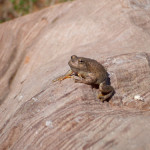Maybe it’s because I grew up on suburban Long Island, but I do have a fondness for golf courses. These open spaces, with their green rolling hills, seemed like “nature” to me when I was a kid.
But golf courses are far from natural and they take their toll on the environment. Golf courses require thousands of gallons of water a day to keep them green. Large quantities of pesticides and fertilizers are used on them, which pollutes local water sources, and harms wildlife. When golf courses are created, animals often lose their natural habitats.
According to an article in the Oregon Environmental News, however, some golf courses are going green. The golf courses’ water hazard, for example, may double as homes for frogs, turtles, and other wildlife. Hardier grass varieties are planted that don’t require as much water, fertilizer, and pesticides. Dead trees are left standing to attract insects, which attracts birds. Water is periodically tested for chemicals, which helps frogs, and other animals. Wildlife corridors allow larger animals to pass through undisturbed.
This is great news for animals and for the environment. I hope this new green (and no, I don’t mean that kind of green) mentality continues to spread among golf course managers and members of golf clubs. If you’re an avid golfer, please show your support for Frog-Friendly (and Bird-Friendly) green courses.
Here’s more information from Audubon International about the Cooperative Sanctuary Program for Golf Courses, a certification program that helps golf courses protect the environment and also preserve the natural heritage of the game of golf. It also includes a list of green golf courses.




